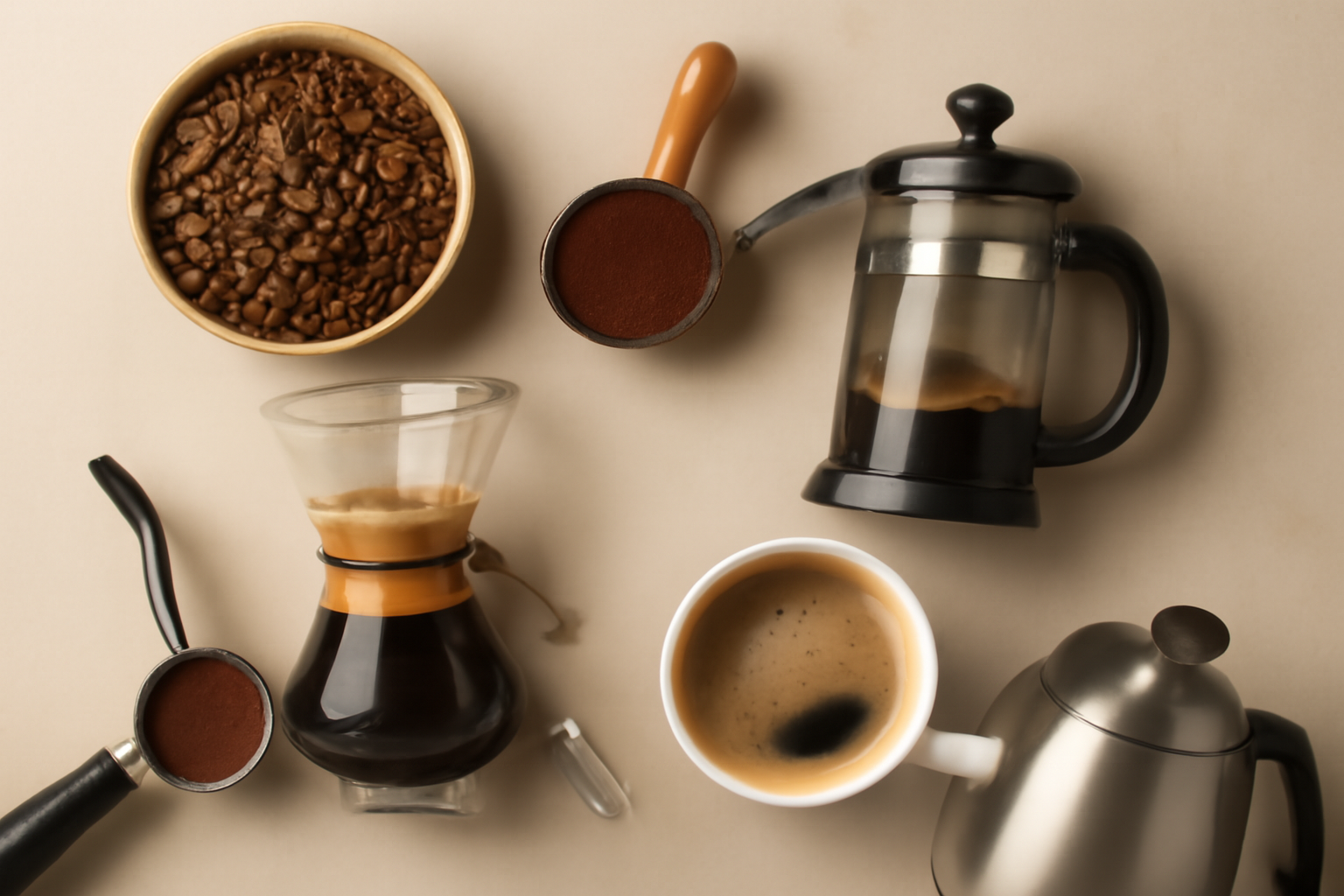There’s nothing like the aroma of freshly brewed coffee to kickstart your day. For many, the perfect cup of coffee can make all the difference between a good and a great morning. Whether you’re an experienced barista or a coffee enthusiast, achieving that ideal cup is both an art and a science. It’s about understanding the coffee beans, the brewing method, and the tools at your disposal.
This guide will walk you through every step to brew the perfect cup of coffee, from selecting your beans to using the right brewing technique. We’ll focus on methods that you can easily replicate at home, so you can enjoy café-quality coffee every day.
Step 1: Choose the Right Coffee Beans
The first step to brewing the perfect cup of coffee starts with selecting high-quality beans. The coffee bean variety, origin, and roast will all have a significant impact on the flavor of your cup. Here’s what to look for:
1.1 Bean Variety
- Arabica Beans: Known for their smooth, nuanced flavors and lower acidity. These are ideal for those who enjoy a delicate, sweet cup.
- Robusta Beans: If you prefer a stronger, bolder cup, Robusta beans might be your best choice. They tend to have a more bitter taste and higher caffeine content.
- Blends: Many specialty coffee shops offer blends of Arabica and Robusta to balance flavor and strength. These can be a great option if you’re looking for something with a little more depth.
1.2 Roast Level
- Light Roast: Ideal for highlighting the subtle flavors of the beans, such as floral or fruity notes. Light roasts are excellent for pour-over and cold brew.
- Medium Roast: A balanced choice that brings out the natural sweetness and acidity. Great for drip coffee or French press brewing.
- Dark Roast: Best for those who prefer a bold, rich coffee with chocolatey or smoky flavors. Dark roasts are perfect for espresso or French press.
1.3 Freshness is Key
No matter what roast or variety you choose, freshness is crucial. Buy whole beans and grind them just before brewing. Coffee starts losing its flavor immediately after grinding, so keeping your beans whole ensures you capture all of their aromatic compounds.
Step 2: Measure Your Coffee
The right ratio of coffee to water is crucial to achieving the perfect balance of strength and flavor. Generally, a standard ratio is 1:15 to 1:18 (1 gram of coffee to 15-18 grams of water). However, the ideal ratio can depend on your personal preferences and brewing method. For example:
- Pour-Over: 1:15 to 1:16
- French Press: 1:15 to 1:17
- Espresso: 1:2 (one gram of coffee for every two grams of water)
2.1 Tools for Accurate Measurement
To ensure accuracy, use a coffee scale to measure your coffee and water. While it may be tempting to use a tablespoon, the weight of coffee can vary greatly based on the grind size, which is why a scale gives you a much more precise result.
Step 3: Grind Your Coffee
The grind size of your coffee is directly related to your brewing method. The finer the grind, the quicker the extraction will occur. The coarser the grind, the slower the extraction.
Here’s a breakdown of grind sizes for different brewing methods:
- Espresso: Fine grind, similar to table salt.
- Pour-Over: Medium grind, similar to sea salt.
- French Press: Coarse grind, similar to breadcrumbs.
- Cold Brew: Very coarse grind, like raw sugar.
3.1 Grinding Freshly
Always grind your beans just before brewing to retain the freshest flavors. The longer coffee sits after grinding, the more it loses its oils and aromas. You can use a burr grinder for a consistent grind size, which ensures an even extraction.
Step 4: Boil the Right Amount of Water
Once your coffee is measured and ground, it’s time to prepare the water. The temperature of the water plays a huge role in how your coffee will taste. Too hot, and your coffee can become bitter and over-extracted. Too cold, and it will be weak and under-extracted.
4.1 Ideal Water Temperature
The perfect brewing temperature for most coffee methods is 195°F (90°C) to 205°F (96°C). This temperature range ensures the coffee’s full flavor profile is extracted without any undesirable bitterness.
- Espresso: 190°F to 200°F (88°C to 93°C)
- French Press: 200°F (93°C)
- Pour-Over: 195°F to 205°F (90°C to 96°C)
4.2 Water Quality
The quality of your water matters, too. Ideally, use filtered water that is free from impurities. Tap water with too many minerals can affect the taste and prevent the coffee from developing its full flavor.
Step 5: Brewing Your Coffee
Now that you have your beans, grinder, scale, and water ready, it’s time to brew. Different methods require slightly different approaches, but the basic idea remains the same: allow the water to extract the coffee’s flavor slowly and evenly.
5.1 Pour-Over Brewing
Pour-over coffee is one of the best methods for creating a clean, flavorful cup. Here’s how to do it:
- Place your filter in the dripper (e.g., Hario V60) and rinse it with hot water to remove any paper taste.
- Add the ground coffee to the filter and shake it gently to level the grounds.
- Pour a small amount of hot water over the coffee to bloom it, allowing the grounds to release gases. Wait for 30 seconds.
- Slowly pour the remaining water in a circular motion, ensuring all the coffee is evenly saturated.
- Allow the coffee to drip through completely, which should take 3-4 minutes.
5.2 French Press Brewing
The French press is ideal for a rich, full-bodied cup of coffee. Here’s how to use it:
- Boil the water and let it sit for about 30 seconds to cool to the proper temperature.
- Add the coarsely ground coffee to the French press (around 1:15 coffee-to-water ratio).
- Pour in the hot water, saturating all the grounds, and let them steep for about 4 minutes.
- After steeping, press the plunger down slowly and steadily, separating the coffee from the grounds.
- Serve and enjoy!
5.3 Espresso Brewing
Espresso is a quick and intense method of brewing. To make a great espresso:
- Preheat your espresso machine and portafilter.
- Grind your coffee to a fine texture and add it to the portafilter, ensuring it’s evenly distributed.
- Tamp the coffee grounds firmly and evenly to create a smooth surface.
- Lock the portafilter into the machine and start the shot.
- The espresso should take about 25-30 seconds to extract.
5.4 Cold Brew Brewing
Cold brew coffee is perfect for those who enjoy a smooth, low-acid cup. Here’s how to brew cold brew:
- Add coarse ground coffee to a jar or pitcher at a ratio of 1:4 or 1:5 coffee to water.
- Stir the mixture and cover it. Let it steep in the fridge for 12-24 hours.
- Strain the coffee using a fine-mesh filter or cheesecloth.
- Serve over ice or dilute it with milk or water.
Step 6: Serve Your Coffee
Once your coffee is brewed, it’s time to enjoy it! For the best experience, serve your coffee in a clean, pre-warmed cup. Coffee served in a warm mug will maintain its temperature longer, ensuring you can enjoy each sip at the ideal drinking temperature.
6.1 Enhancing the Flavor
If you prefer, you can add milk, sugar, or flavorings like vanilla or cinnamon to enhance your coffee’s flavor. However, for those who want to truly savor the coffee, drinking it black allows you to appreciate the full depth of its flavors.
Conclusion: Perfecting Your Coffee Every Time
Brewing the perfect cup of coffee is an art form that takes practice, but by following these steps, you can consistently achieve a cup that’s full of flavor, aroma, and satisfaction. Remember that each brewing method is unique, and personal preferences play a huge role in the process. With the right tools, technique, and attention to detail, you can brew a coffee that rivals your favorite café.

I’m an economist with 15 years of experience in strategic planning and a lifelong passion for wellness and natural living. As a self-learner, I created Herbalife Balance to share insights on healthy eating, mindful habits, and an active lifestyle. Tennis enthusiast and nature lover, I believe in balance as a path to well-being. Through this blog, I help others live healthier, more conscious lives.

